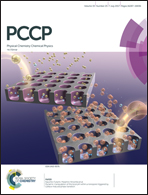Anomalous photovoltaic effect based on molecular chirality: influence of enantiomeric purity on the photocurrent response in π-conjugated ferroelectric liquid crystals†
Abstract
(S)- and (R)-forms of chiral π-conjugated ferroelectric liquid crystals were synthesized. The dielectric properties in the ferroelectric liquid-crystalline (FLC) phases were evaluated using the Sawyer–Tower method. Spontaneous polarization of (S)-1 reached 68 nC cm−2 at 127 °C. Hole mobilities in the FLC phases estimated using the time-of-flight (TOF) method were on the order of 10−4 cm2 V−1 s−1. Each chiral π-conjugated compound exhibited a photovoltaic effect based on spontaneous polarization without p–n or Schottky junctions. This phenomenon could be attributed to an anomalous photovoltaic (APV) effect that has been observed in ferroelectric ceramics. In addition, liquid-crystalline enantiomeric mixtures of (S)-1 and (R)-1 were prepared and the APV response under UV illumination was studied. The APV response was enhanced with an increase in enantiomeric purity and was minimized in the racemic mixture. From this result, it was concluded that the APV effect in this FLC compound originated from the molecular chirality.



 Please wait while we load your content...
Please wait while we load your content...